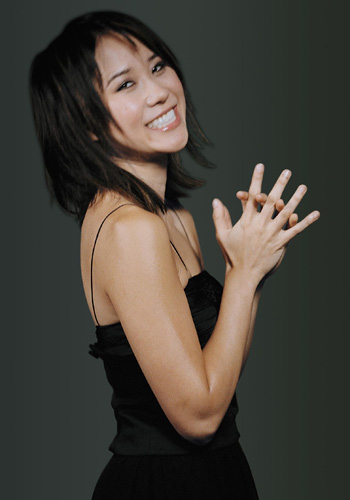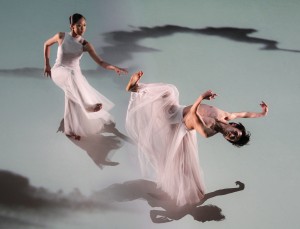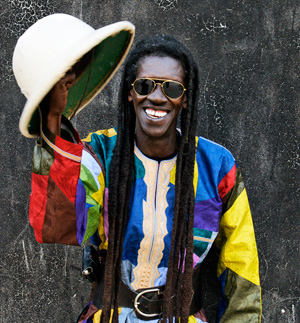Georgian Folksong Visits Ann Arbor
It’s obvious from just a glance at this season’s calendar that the UMS has a priority of bringing non-Western performers to Ann Arbor. The list this year includes, among others, Chinese opera, Japanese drumming, a Mexican mariachi band, a South Indian classical dance company, and legendary singer-songwriters from Benin and Brazil. The consistency of this kind of scheduling from year to year is testimony to the fact that Ann Arbor audiences love this programming.
The prominence of so much international variety got me wondering how long American classical concert-going audiences had been fascinated with unfamiliar, or at least non-classical, performers. I knew it went back at least as far as the late 1930s when the Trapp Family Singers, playing recorders and violas da gamba and wearing traditional rural Austrian costumes, were treated as an exotic commodity. (Ironically, they initially performed almost exclusively classical repertoire, but on the advice of marketers, adopted the kind of folk repertoire for which they became best known. A rosy-cheeked family wearing dirndls and lederhosen just looked like they ought to be singing native folk songs instead of Renaissance madrigals and Baroque motets.)
It turns out that in the case of the UMS, a commitment to international performers from beyond the world of Western concert music reaches even further into the past, and to more authentically foreign cultures. The Russian Cossack Chorus, an all-male ensemble, appeared in its 48th season (1926-1927). The Chorus sang one selection each by Tchaikovsky and Borodin and a few classical pieces by forgotten Russian composers, but the program consisted mostly of folk song. The performance must have been a hit, because between 1932 and 1951, the Don Cossack Chorus (the most successful of a number of expatriate Cossack choirs established in Eastern Europe in the wake of the October Revolution and the Russian Civil War) appeared on UMS programs in nine seasons. The late 1940s and early 1950s brought performances by choirs from Iceland and Finland that incorporated authentic folk material, but it wasn’t until the 1960s that the programming started developing the variety that has become characteristic for UMS.
In 1961, Bayanihan, a Philippine Dance company, expanded the concert series’ focus both geographically and with the inclusion of dance. From that point on, international programming grew with amazing speed. The 1972-1973 season, for instance, included a total of 55 performances, and ten of those were by non-Western musicians or dancers. It’s a trend that has continued, and today UMS programming routinely extends the range of cultures, nationalities, and performance styles represented on its schedule.
The appearance of Ensemble Basiani, an a cappella men’s choir from the Republic of Georgia, provides a nice symmetry with the UMS’s first non-Western performance by the Russian Cossack Choir, 85 years ago. Ensemble Basiani, however, promises to offer a window into a musical culture far more remote and complex than that of the Cossack choirs.
The musical traditions of Georgia are hardly known in the West, but the uniqueness of the music won it a designation from UNESCO in 2001 as a masterpiece of the “Oral and Intangible Cultural Heritage of Humanity.” It is so distinctive that a Georgian folksong was included among the examples of the Earth’s cultural diversity in the 1977 Voyager probe. When Igor Stravinsky was asked late in life what he considered to be the most exciting modern music, his answer was (in addition to a piece by Schoenberg), “Georgian polyphonic folk song… this active musical performance tradition with its roots in the ancient past is something remarkable that offers more to performance than all of the achievements of modern music.”
With endorsements like those, how could anyone pass up an opportunity to hear Ensemble Basiani? But what exactly should you expect to hear? It’s always true that writing about music is no substitute for hearing the music itself, but some analogies are helpful for getting oriented to Basiani’s sound.
Although there are significant differences between the groups, Ensemble Basiani’s styles of vocal production are in some ways similar to those of the Bulgarian State Radio & Television Female Vocal Choir, whose album Le Mystère des Voix Bulgares was a runaway international hit in both World Music and Classical Music markets about 25 years ago. The voices have a fiercely penetrating purity and there is considerable use of what would be called “extended vocal techniques” in contemporary music, such as yodeling, chanting, droning, bending of tone, and a wide range of vocal timbres that includes a piercing nasal quality. Most of the music itself, both liturgical and folk, is polyphonic, meaning that there are several melodic lines going on at once. This is in dramatic contrast to most Western folksongs, which consist of a clearly defined melody with a simple accompaniment. Georgian polyphony is usually in three parts, but the ways the parts are distributed among the voices can create the impression of an even more richly complex texture.
From Bulgarian State Radio & Television Female Vocal Choir performance:
Georgian music has little relation to Western concepts of tonality, and can shift modes unpredictably, with breath-taking results. The Western idea that dissonance must resolve into consonance is foreign to Georgian music, but the dissonance is sung so naturally and effortlessly that as the listener’s ears get acclimated, it’s possible to hear it as intensely expressive. The essential impression a listener is likely to take away is that this is music of primordial power that comes from a very distant past and a unique, remote culture.
From an Ensemble Basiani performance:
At its only previous US performance, at Lincoln Center’s Mostly Mozart Festival in 2010, Basiani received tremendously positive reviews. The UMS performance at 7:30 pm on Thursday, October 4 at St. Francis of Assisi Church is its Michigan premiere.
11/12 Asia & World Series
Asia
UMS focuses its global programming on four different regions of the world — the Arab World, Africa, the Americas, and Asia — with one region enjoying a particular focus during each season. Following the celebration of the performing arts of the Americas in the 10/11 season, UMS turns its thematic focus to Asia, specifically highlighting artists from China, Taiwan, Inner Mongolia, and India.
Subscription packages go on sale to the general public on Monday, May 9, and will be available through Friday, September 17. Current subscribers will receive renewal packets in early May and may renew their series upon receipt of the packet. Tickets to individual events will go on sale to the general public on Monday, August 22 (via www.ums.org) and Wednesday, August 24 (in person and by phone). Not sure if you’re on our mailing list? Click here to update your mailing address to be sure you’ll receive a brochure.
Yuja Wang, piano
Sunday, October 9, 4pm
Hill Auditorium
Twenty-four-year-old Chinese pianist Yuja Wang is widely recognized for playing that combines the spontaneity and fearless imagination of youth with the discipline and precision of a mature artist. She made her UMS debut in January 2008, just months after graduating from the Curtis Institute of Music, and since then has spent each year criss-crossing the globe with a cavalcade of impressive debuts and awards, including the prestigious Avery Fisher Career Grant, given to select musicians destined for bright solo careers.
Program
Ravel | Miroirs
Copland | Piano Variations
Rachmaninoff | Selected Preludes
Brahms | Sonata No. 1 or No. 3
Water Stains on the Wall
Cloud Gate Dance Theatre
Lin Hwai-min, artistic director
Friday, October 21, 8pm
Saturday, October 22, 8pm
Power Center
Trained in tai chi, meditation, Chinese opera movement, modern dance, and ballet, Cloud Gate Dance Theatre performs a rich repertoire with roots in Asian myths, folklore, and aesthetics, all infused with a contemporary perspective. For this long-awaited UMS debut, Cloud Gate presents Hwai-min’s newest work, Water Stains on the Wall. “Water stains on the wall” is a popular metaphor that represents the highest state in the aesthetics of Chinese calligraphy. Hwai-min and dancers take off from this metaphor and create and abstract work of beauty and magic that stands sublimely on its own.
AnDa Union from Inner Mongolia
Wednesday, November 9, 7:30pm
Michigan Theater
Formed in 2003, AnDa Union’s 14 members all hail from the Xilingol Grassland area of Inner Mongolia, a semi-autonomous region of China. AnDa Union are part of a musical movement that is finding inspiration in old and forgotten folk music from the nomadic herdsman cultures of Inner and Outer Mongolia, drawing on a repertoire of music that has all but disappeared during China’s recent tumultuous past. Its members are accomplished singers and instrumentalists, performing on the traditional horse-head fiddle (tsuur), the maodun chaoer, a three-holed flute, as well as Mongolian versions of the dulcimer, zither, lute, and mouth harp.
Beijing Guitar Duo with Manuel Barrueco
Sunday, November 20, 4 pm
Rackham Auditorium
Meng Su and Yameng Wang are widely noted for their outstanding technique and artistic musicality. They first met at the Central Conservatory in Beijing, where they began studying with the acclaimed professor Chen Zhi as children. Both women have won the Tokyo International Guitar Competition (Yameng Wang won it at age 12), and have received heaps of acclaim and recognition at international guitar events and from other seasoned guitarists, including Sergio Assad who has written and dedicated works to them. In 2008, they went to study with Manuel Barrueco at the Peabody Conservatory of Music in Baltimore and officially established themselves as the Beijing Guitar Duo. Both individually and together, their impressive talents come together to create one of the most excited guitar duos on the scene today.
Chamber Ensemble of the Shanghai Chinese Orchestra
Friday, February 10, 8pm
Rackham Auditorium
The 20 members of the Shanghai Traditional Chamber Ensemble are drawn from the first large-scale modern orchestra of traditional instruments in China. While Chinese stars such as Lang Lang have brought new attention to Western classical music in China, this ensemble provides a window into the traditional Chinese classical music that dates back centuries.
Zakir Hussain and the Master Musicians of India
Fazel Qureshi, tabla and kanjira
Rakesh Chaurasia, bansuri
Dilshad Khan, sarangi
Navin Sharma, dholak
Abbos Kosimov, doyra
Meitei Pung Cholom Performing Troupe (Dancing Drummers of Manipur)
Thursday, April 12, 7:30pm
Hill Auditorium
Zakir Hussain is today appreciated both in the field of percussion and in the music world at large as an international phenomenon. A classical tabla virtuoso of the highest order, his consistently brilliant and exciting performances have not only established him as a national treasure in his own country, but have earned him worldwide fame. For this return appearance, he performs with a host of Indian classical music greats, as well as the dancing drummers of Manipur.
Other World Music
In addition to the events from Asia listed above, UMS presents Goran Bregovic and His Wedding and Funeral Orchestra, which combines a Serbian Gypsy Band, string ensemble, orthodox male choir, and two Bulgarian female vocalists in a wild ride in Hill Auditorium; flamenco star Diego El Cigala; Max Raabe and Palast Orchester, recreating the high style and musical glory of the Weimar era; and Senegalese singer/songwriter Cheikh Lô.
Goran Bregovic & His Wedding and Funeral Orchestra
A Serbian Gypsy Band, Classical String Ensemble,
Orthodox Male Choir, and Two Bulgarian Female Vocalists
Saturday, October 15, 8 pm
Hill Auditorium
“It was party time…a Balkan free-for-all, and the jam-packed auditorium went wild…” (The Jerusalem Post) Balkan music icon and acclaimed film composer Goran Bregovic celebrates the music of Europe’s Gypsy tradition. With a 20-piece ensemble consisting of a Serbian gypsy band, a classical string ensemble, an all-male choir, two Bulgarian female singers and Bregovic’s own electric guitar, the music blends raucous gypsy dance tunes with traditional Eastern European choral music, spinning it all through a rock ‘n roll cycle.
Diego El Cigala
Saturday, November 5, 8 pm
Michigan Theater
Diego is a famous flamenco singer who started off by singing for well-known flamenco dancers but has since “moved to the front,” which in flamenco slang means to sing on one’s own instead of accompanying a dancer. He has collaborated with a variety of musicians, including Bebo Valdés, the Cuban pianist and bandleader with whom he recorded Lágrimas Negras, an album that created a sensation in Spain, becoming one of the best-selling albums in that country’s history and receiving a pile of awards, including five Latin Grammy nominations and the New York Times’ 2003 “Album of the Year” honors.
Berlin Nocturne
Max Raabe & His Palast Orchester
Saturday, March 10, 8pm
Hill Auditorium
“Max Raabe and his 12-piece Palast Orchester are re-creating the music of the Weimar era with verve and class.” (Time Out New York) A nostalgic homage to the legendary nocturnal flair of the Weimar Era, the debonair Max Raabe embodies the high style and music glory of the 1920s and 1930s, all backed by his stellar 12-member band. His art lies in revealing the enigmatic intelligence, ambiguity, musical power and complexity of the “German chansons” from the turbulent Weimar Republic — and then shaking it up with a completely unexpected cover from the contemporary pop realm.
Cheikh Lô
Friday, April 13, 8pm
Michigan Theater
Cheikh Lô is one of the great mavericks of African music. A superb singer and songwriter, as well as a distinctive guitarist, percussionist, and drummer, he has personalized and distilled a variety of influences from West and Central Africa to create a style that is uniquely his own. After emigrating to Paris and then returning to Senegal in the late 1980s, Lô attracted both the attention of and comparisons to Youssou N’Dour, who produced two of his early albums. His signature blend of semi-acoustic flavors — West and Central African, funk, Cuban, flamenco — has been distilled into his most mature, focused, yet diverse statement today, with his husky, sensual voice sounding better than ever.
Return to the complete chronological list.
Are there any arpas llaneras in the southeast Michigan area?
If you travel by air enough, eventually you’ll show up at your destination but your bags won’t. When this has happened to me, my missing luggage has eventually shown up, but it’s never fun. The pressure is worse when the missing luggage is your instrument and you have a performance that night.
Two years ago, I went to the airport to pick up Lila Downs and her band. All of the band members arrived, but one of them, Edmar Castañeda, was missing his arpa llanera or Colombian folk harp.
I wasn’t aware of anywhere in Ann Arbor to borrow or rent an arpa llanera, so I left Edmar and the tour manager at the airport. They tracked down the harp while I drove the rest of the group to Ann Arbor for their sound check.
Fortunately the harp was found in time for the concert. The harp sound along with Edmar’s unique approach to the instrument added a great touch to Lila’s music. I spoke with other UMS staff members after the concert who also marveled at Edmar’s harp playing. I was even more impressed when, after the concert, Edmar told me he had only been playing with Lila’s band for a short time. If I remember correctly it was only a couple weeks.
I have been looking out for Edmar’s music ever since. I saw this video on NPR’s website and wanted to share it with you. It showcases an artist who was not the main attraction, but added significantly to the quality of a UMS performance. On the video, you’ll hear Edmar’s novel technique through the mix of traditional Colombian dance music (joropo music) with jazz and Afro-Cuban music.
Do you remember this concert? Are there any arpas llaneras in the southeast Michigan area?








